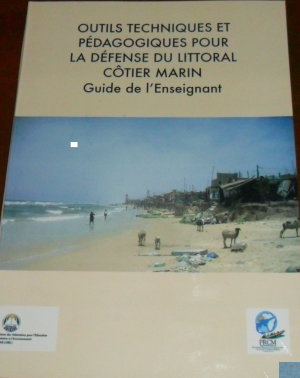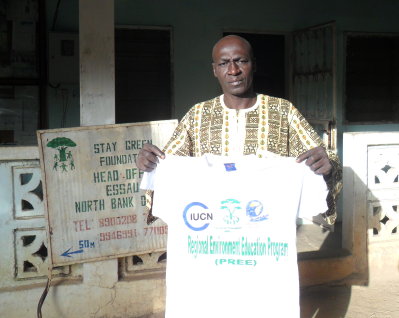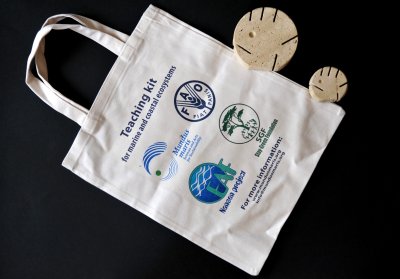From the needs assessment to action
Of the total of 35 schools in Senegal and The Gambia (15 primary and 11 secondary schools in Senegal and 7 primary and 2 secondary schools in The Gambia), which participated in the needs assessment survey, nine have confirmed their interest to participate in pilot activities.
-
Primary School Kayar 1 (Senegal)
-
Ecole primaire de Hann Montagne (Senegal)
-
Immaculate Lower Basic School, Gunjur (The Gambia)
-
Tanji Lower Basic School (The Gambia)
 The preparations of the pilot activities are in full swing, actively involving local partners.
The preparations of the pilot activities are in full swing, actively involving local partners.
In Senegal, the Union of Volunteers in relation to Environment Education (UNI.V.ERE - l’Union des Volontaires de l’Education Relative à l’Environnement) is an NGO working on the promotion of environmental issues in the national curriculum.
Two founding members are Gora Kane, retired school system inspector and president of UNI.V.ERE, and Seydou Sow, the Director General of “Nouvelles Editions Africaines du Sénégal”. They have already developed a teaching aid to support teachers' work on environment themes.
The teaching aid has been prepared in the context of the regional IUCN project on environmental education and will help to use the IUCN knowledge handbook “Discovering the coastal and marine environment in West Africa” effectively in schools.
The two leaders of UNI.V.ERE are understandably keen to see some practical trials carried out using the existing educational materials and additional ones under preparation by this Mundus maris project.
Having such experienced partners engage with the pilot activities is expected to support quality in design, implementation and evaluation.
In The Gambia, Stay Green Foundation (SGF) is a recognised NGO, particularly active in environment protection on the North Bank of the country. SGF is headed by Baboucarr Mbye, who has extensive experience in training the trainers on environmental matters combined with gender and wider social equity concerns. SGF is a regular collaborator with IUCN and has in turn some female teachers working more particularly in the coastal zone from Banjul to Gunjur, particularly Therese Jatta et Fatou Duti Jatta.
 The Director of the Serekunda Primary School, Bolong Turay, is having his hands full already with the management of his well-run school with some 4000 pupils. All the same, he welcomed the concept of the pilot activities and indicated his willingness to host the preparatory and evaluation workshops to get the teaching trials done in the first quarter of 2012.
The Director of the Serekunda Primary School, Bolong Turay, is having his hands full already with the management of his well-run school with some 4000 pupils. All the same, he welcomed the concept of the pilot activities and indicated his willingness to host the preparatory and evaluation workshops to get the teaching trials done in the first quarter of 2012.
- The period of December 2011 and January 2012 is being put to good use to put together teacher support kits composed of the IUCN knowledge handbook “Discovering the coastal and marine environment in West Africa”,
- Teaching aids, e.g. 'Outils techniques et pédagogiques pour la défense du littoral côtier marin' (Technical and pedagogical tools for the protection of the coastal marine environment) prepared by UNI.V.ERE.
- Additional guiding notes and visual aids (posters, fish rulers) prepared by Mundus maris.
Fish rulers are not entirely new to the region. Birane Samb, at the time a researcher at the Marine Research Centre (CRODT) in Dakar and partner in the INCOFISH international research collaboration about 'Reconciling multiple demands on coastal zones', had already prepared one a few years back. The fish ruler shows the image of major fish species, which are overfished already and indicates the minimum size at which the fish will have reproduced. If only larger specimens are caught, the population should be safe from collapse, even be able to rebuild and to sustain a productive fishery. The research project produced a routine on its website to help anybody interested to develop such fish rulers for their country or part of the sea. They have recently been promoted e.g. in Germany by the consumer protection agency in Hamburg and Peru through a collaboration between IMARPE, the national Fisheries Research Institute, and Mundus maris.
 Experiences since the first exploration of fish rulers hold some lessons. The pioneers used the strict scientific definition of "length at first maturity", meaning the total length at which 50% of the population have reproduced (that means, the other half has not). As overfishing continues and stocks collapse, scientists now propose a minimum length at which 90 or 100% of the individuals in a fish population have reproduced at least once. If this were generally applied, stocks would not collapse anymore from overfishing and the total weight produced for human consumption would automatically be higher (bigger size = more fish to eat). In other words, it would be a win-win situation for all concerned, not only for the fishers themselves.
Experiences since the first exploration of fish rulers hold some lessons. The pioneers used the strict scientific definition of "length at first maturity", meaning the total length at which 50% of the population have reproduced (that means, the other half has not). As overfishing continues and stocks collapse, scientists now propose a minimum length at which 90 or 100% of the individuals in a fish population have reproduced at least once. If this were generally applied, stocks would not collapse anymore from overfishing and the total weight produced for human consumption would automatically be higher (bigger size = more fish to eat). In other words, it would be a win-win situation for all concerned, not only for the fishers themselves.
Implementation schedule
-
Between end January and mid February 2012 a two-day workshop will be convened in each of the two participating countries with two teachers from each school, a school inspector and resource persons from the local partner organisations together with the Mundus maris local coordinator, Aliou Sall. The aim is to present and critically discuss the pedagogical support kit, setting up a schedule for testing the pilot teaching modules and agreeing on a monitoring and evaluation scheme.
-
Between February and early March 2012 all test activities should be carried out in the participating schools and carefully monitored. Monitoring and evaluation (M&E) sheets will be used to collect experience from using the teaching aids in real life situations. M&E are particularly important to learn lessons for future use and possible updates of teaching aids and eventual their roll out.
-
Between early and late March 2012 a workshop will be convened in each country to review the experience and analyse lessons together for the future. Participants will be the same as in the first workshop.
-
The collective experience will be written up by Mundus maris in April 2012 and validated by participants in view of reporting back results and an outlook to FAO's EAF Nansen Project.
Mundus maris will also encourage use of free web resources, which can be accessed via internet. Among these is the global web archive on all fishes - FishBase. A fish quizz and other apps will shortly be available via mobile phones, which are more widely distributed than internet-connected computers.








